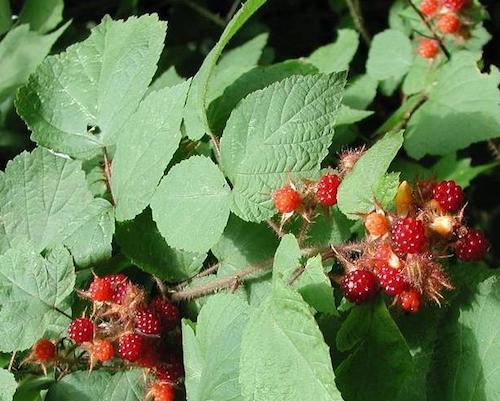Wineberry or Wine Raspberry
by Nancy Miller, Fairfax Master Gardener
 The wineberry, Rubus phoenicolasius, is a perennial deciduous shrub in the rose family that has a fountainlike shape with stems growing from a central crown. It is pollinated by insects and yields an edible seedy raspberry-type fruit. This shrub is considered one of the most troublesome invasives destroying our forests in the northern piedmont.
The wineberry, Rubus phoenicolasius, is a perennial deciduous shrub in the rose family that has a fountainlike shape with stems growing from a central crown. It is pollinated by insects and yields an edible seedy raspberry-type fruit. This shrub is considered one of the most troublesome invasives destroying our forests in the northern piedmont.
Originally from eastern Asia, it was imported to use as rootstock for raspberry breeding in 1890, but it escaped. Now it can be found from Vermont to Georgia, and west to Michigan and Arkansas. In Virginia, we most often find it along the Blue Ridge and the piedmont of Northern Virginia.
It grows at a medium rate to 9 feet high (2.5 m) by 3 feet (1 m) wide. Wineberry’s arching stems reach 3 to 6 feet (1 to 2 m). Wineberry will root at its tips, as well as from its seeds, root sprouts and rhizomes, forming very extensive, dense thickets. These thickets prevent forest regeneration, restrict enough light to obliterate wildflowers and make it very difficult for hikers and wildlife to use infested forests and fields because of the tangles of hazardous branches. First year canes are vegetative (not flowering). Second year canes (floricanes) become woody with side branches that produce flowers, fruit and then die. This combination of living and dead prickly canes adds to the thickets’ hazards.

Wineberry fruit
Wineberry has reddish, thorny stems with razor-sharp red or green prickles. These canes have alternate leaves of three leaflets, broadly ovate with pointed tips, serrated margins and white undersides covered with dense hairs. Its flowers are small and pinkish with prominent green sepals and five petals. The fruit is red with fine hairs, growing in an aggregate of drupelets that ripen in mid-summer. They are not true berries. When the fruit is picked, it separates from the core, forming a hollow shell.
Wineberry is delicious freshly picked or in baked goods — enjoyed by humans, birds, bears and other wild creatures. At least when eaten by humans, the seeds do not return to the soil to generate more plants.
You will find wineberry growing in a wide range of soil and light conditions, except in very dense shade. It grows most vigorously in moist soil and mesic hardwood forests. It will establish quickly along roadsides, streams, and in hedgerows, fallow fields and forest margins. Prime growth territory is tree-fall areas within forests where the increased sunlight encourages growth.
A close relative, the common blackberry (Rubus allegheniensis), can be distinguished easily. Wineberry and blackberry fruits ripen about the same time, but the blackberry goes from green to dark purple-black and continues to develop for several weeks after the wineberry is finished. Blackberry canes have green or red-brown bark and form thickets only in full sun.

Extent of US where Wineberry has spread
How can you help control this invasive? You can physically uproot the crown, removing as much of the root system as possible at any time. Hand-pulling early in the season while growth is small is much easier to manage. For over one quarter of an acre, intensive treatments are needed: mowing/cutting when the bush is not fruiting, back-mounted propane torches, targeting fire at the base of the bush or grazing. Native animals will not consume non-native plants, but goats are an exception. Their choices may result in resprouting or require special training/permits. If you decide on an herbicide, please consider desirable plants that might be affected, your expertise and training and availability of appropriate herbicides. Always read the entire herbicide label; you are required by law to follow the label on the pesticide container.
Alternative Plants to Wineberry:
• Coralberry (Symphoricarpos orbiculatus)
• Black Raspberries (Rubus occidentalis)
• Mapleleaf Viburnum (Viburnum acerifolium)
- References
- Non-Native Invasive Species Control Treatments, Pest Management Guide, Virginia Department of Forestry and Blue Ridge PRISM
- Wineberry or Wine Raspberry, Blue Ridge Partnership for Regional Invasive Species Management
- Rubus phoenicolasius, North Carolina Extension Gardener Plant Toolbox
- Wineberry (Rubus phoenicolasius), University of Maryland Extension
- Wineberry (Rubus phoenicolasius Maxim.), Connecticut Invasive Plant Working Group, University of Connecticut
- Wine raspberry Rosaceae Rubus phoenicolasius Maxim., Virginia Tech Department of Forest Resources and Environmental Conservation